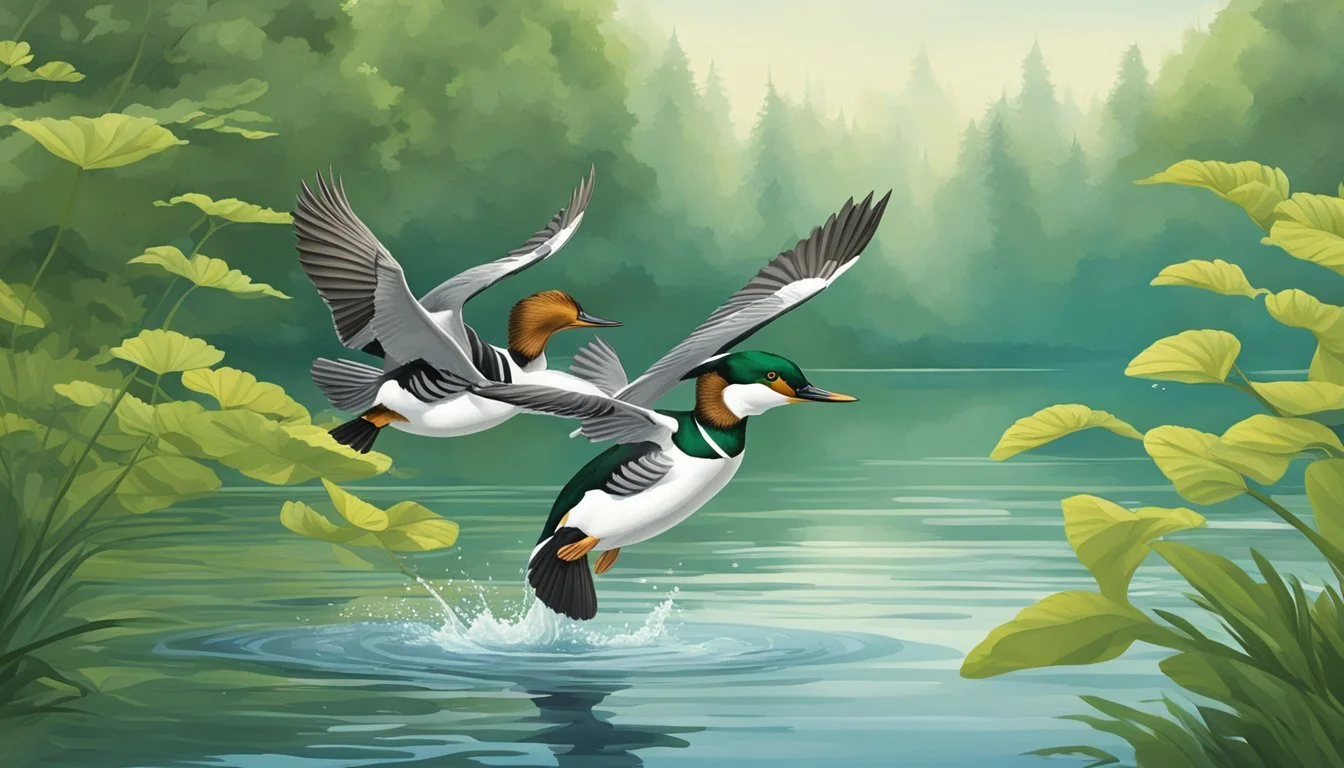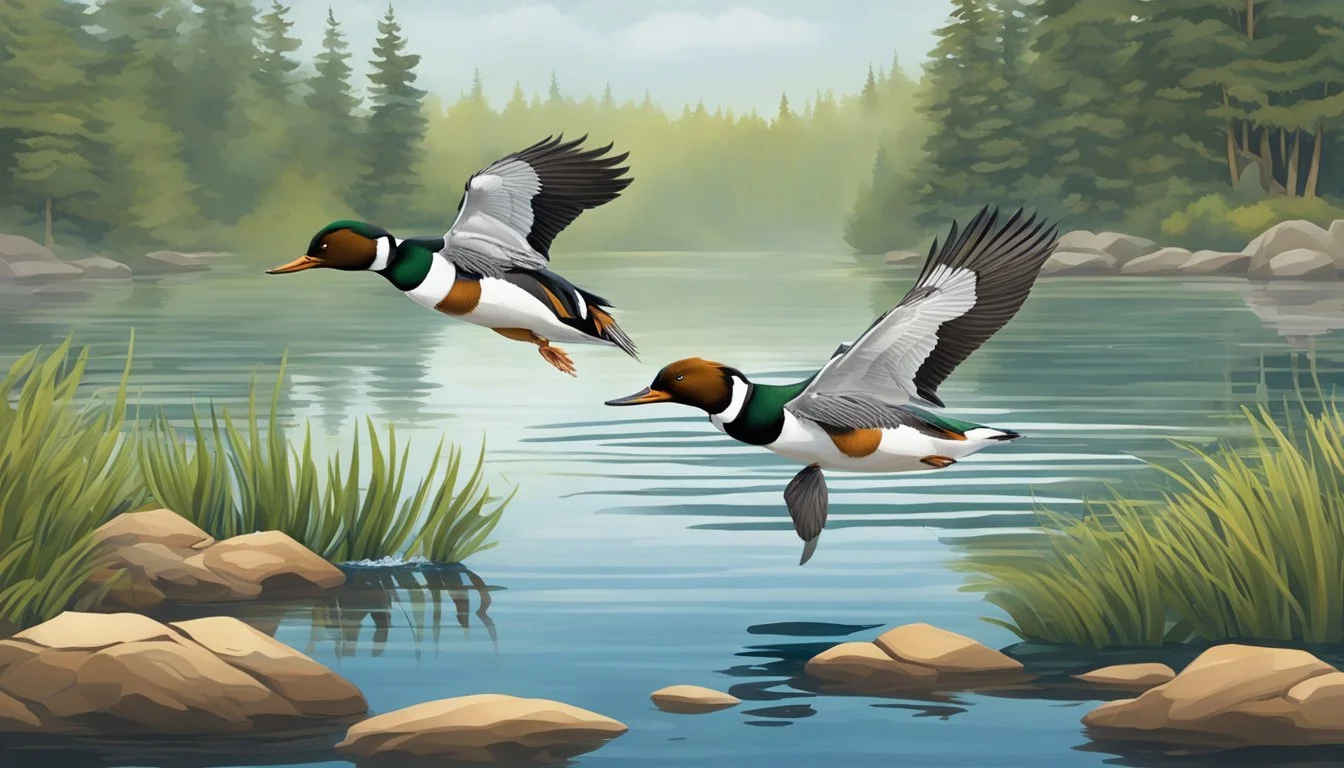Mergansers Hunting for Beginners
Essential Tactics and Strategies
Mergansers are a distinctive group of waterfowl that present an exciting challenge for hunters in North America. These diving ducks (What wine goes well with duck?) are admired for their unique appearance and agile hunting abilities in aquatic environments. With species like the hooded merganser, which is notable for its striking plumage and full crest, and the common merganser, recognized by its iridescent green head and elegant body, their pursuit requires specialized knowledge and approach.
Hunting mergansers is a pursuit that takes hunters to a variety of waterways, from the forested regions with clear-water rivers to small ponds where these birds feed on fish and crustaceans. The common merganser, for example, is often found in the northern regions of North America and favors nesting in tree cavities or nest boxes near rivers. Successful merganser hunting relies on understanding these ducks' habitats, migratory patterns, and behavior.
For a beginner, starting the hunt for mergansers can be an exhilarating entry into the realm of waterfowling. Hunters need to equip themselves with the knowledge of effective decoy placement, the importance of camouflage, and the art of calling to mimic these ducks' distinct vocalizations. Additionally, the handling of the catch is paramount, as the preparation of mergansers has its intricacies to ensure a palatable meal, given their diet which can affect their taste. Hunting these birds offers both a challenging and rewarding experience for those new to the sport.
Understanding Mergansers
Mergansers are a group of ducks notable for their diving capabilities and specialized bills, making them unique among North American waterfowl. Those interested in merganser hunting should familiarize themselves with species variations, identifying features, and preferred environments.
Species Overview
Common Merganser (Mergus merganser): A large species found across the northern hemisphere, common in both North America and Eurasia. Hooded Merganser (Lophodytes cucullatus): A smaller species with striking plumage and a distinctive crest, predominantly North American. Red-breasted Merganser (Mergus serrator): Recognizable by its rust-colored breast, this species is often seen in northern freshwater and coastal marine environments in North America.
Physical Characteristics
Plumage: Varies among species; hooded mergansers exhibit the most elaborate with males displaying a bold black and white crest.
Bills: Long, thin, and edged with serrations, these are adapted for catching fish, hence their classification as fish ducks.
Size:
Common Merganser: Males about 25.5 inches, Females 22.9 inches
Hooded Merganser: Maximum length approximately 20 inches
Red-breasted Merganser: Similar in size to the common merganser
Habitats and Distribution
North America: Across Canada and into the United States, even reaching into Mexico for some species
Water Sources: Commonly found in clear freshwater rivers, lakes, and coastal waters
Nesting: Preference for tree cavities or nest boxes; hooded mergansers require nearby trees while common mergansers also utilize cliff crevices and ground nests
Mergansers offer a distinct challenge for hunting enthusiasts, with their adept diving and swift movements in water. A comprehensive understanding of each species, their appearance, and habitat preference is essential for a successful hunting experience.
Preparation for Merganser Hunting
Proper preparation is essential for a successful merganser hunt. An individual must equip themselves with the correct gear and be well-versed in the pertinent hunting regulations.
Hunting Gear and Equipment
Merganser hunters should invest in a range of equipment to ensure efficiency and safety during the hunt. Considering that mergansers are a type of waterfowl, appropriate gear is similar to that used in duck hunting but tailored to the habits of this specific bird.
Firearms and Ammunition: A shotgun suitable for waterfowl hunting, typically 12 or 20 gauge, is necessary. Use steel, bismuth, or tungsten shot as lead shots are prohibited for waterfowl hunting.
Clothing: Water-resistant camouflage clothing is recommended to stay dry and blend into the surroundings.
Decoys: Employing a mixture of common merganser and other duck decoys can be effective. Configuring them to mimic a natural setting is critical.
Calls: Merganser-specific calls are not common, but general waterfowl calls can be used sparingly to attract these birds.
Blind: A hunting blind suitable for the chosen hunting environment, whether it is a ground blind or a boat blind.
Boat: If hunting in open water, a boat might be necessary. Ensure it is camouflaged and safe.
Hunting Licenses and Regulations
Before setting out, hunters must procure the appropriate licenses and be familiar with the specific hunting regulations for the area.
Licenses:
Federal Duck Stamp
State Hunting License (specific to waterfowl if required)
Regulations:
Hunting Season: Know the specific dates for merganser hunting season in the targeted region.
Bag Limits: Understand the daily and possession limits for common, red-billed, and hooded mergansers.
Reporting: Some areas require hunters to report their harvest. Being prepared to do so is essential.
Each state may have additional requirements or restrictions, such as hunter education courses, so hunters should check with local wildlife agencies for the most up-to-date information.
Hunting Techniques
When targeting mergansers, understanding their unique behaviors is key to successful hunting. They are adept swimmers and divers, often hunting fish which dictates specific techniques for effective decoy strategies and retrieval methods.
Decoy Strategies
Mergansers are attracted to the sight of other ducks on the water, making the use of decoys a critical element in hunting tactics. The deployment of decoys should mimic natural merganser behavior. It is advisable to use:
Decoy Spread: Position a mix of merganser and other duck species to create a realistic setting. A ratio of one merganser decoy for every three other duck decoys can be effective in not over-representing the species, as they are typically fewer in number.
Motion Decoys: Mergansers are attracted to movement. Including a few motion decoys can enhance the spread’s appeal by simulating the natural movement of swimming ducks.
Diving and Retrieval Methods
Mergansers are divers and may submerge to escape hunters or pursue prey. For retrieval, hunters should implement:
Proper Timing: Wait for mergansers to resurface from a dive before taking a shot, as they can stay submerged for significant periods.
Retrieval Aids: Employ a trained retriever dog familiar with diving to assist in fetching downed mergansers as they can swim away or dive even when wounded.
Adhering to these specific hunting techniques can notably increase a hunter's success in merganser hunting.
Merganser Behavior and Patterns
Understanding the behaviors and patterns of mergansers is crucial for any beginner looking to hunt these birds. Their distinct feeding habits, migration cycles, and breeding behaviors are key factors affecting their presence in various habitats.
Feeding Habits
Mergansers are skilled aquatic hunters primarily feeding on fish, but their diet also includes amphibians, insects, and crustaceans. They have serrated bills which help them catch and grip slippery prey. Commonly, these ducks forage alone, but at times they can be observed working in small groups to herd fish for easier hunting.
Prey: Fish, amphibians, insects, crustaceans
Hunting Technique: Solitary or small groups for herding prey
Bill: Long, thin, and serrated for gripping
Migration and Seasonal Movements
Mergansers exhibit pronounced migration patterns, often moving from their breeding areas to suitable wintering grounds. These migrations are influenced by weather patterns and the availability of open water. During winter, they prefer ice-free bodies of water where fish are accessible. The timing and extent of these movements can vary annually based on environmental conditions.
Winter: Seek ice-free water bodies
Migration Drivers: Weather, food availability
Breeding and Nesting Behaviors
During the breeding season, female mergansers lay their eggs in nests which are often located in the cavities of trees near water. These nests can be natural or artificial, like nest boxes provided by conservation programs. Females incubate their eggs solely for a period of 30-35 days. After hatching, ducklings may stay in the nest for over a day before leaving to feed themselves. The female tends to the young for several weeks, although the young are capable of feeding independently at an early stage.
Nesting Sites: Tree cavities or nest boxes
Incubation: Female only, 30-35 days
Duckling Independence: Capable of early self-feeding
Conservation and Management
In managing merganser populations, it is crucial to monitor their numbers and ensure their habitats are preserved. Conservation efforts play a significant role in sustaining healthy populations and preventing species from becoming threatened.
Population Dynamics
Merganser populations fluctuate due to various factors, including habitat quality, availability of food sources, and predation rates. Data on breeding pairs and the number of eggs laid contribute to understanding population trends. Monitoring efforts help wildlife managers make informed decisions regarding hunting limits and conservation strategies.
Breeding Success: Regular surveys can indicate the health of merganser populations through metrics such as nest success rate and chick survival.
Migration Patterns: Changes in migration can reflect alterations in habitat conditions, both in breeding and wintering grounds.
Conservation Efforts
Conservation initiatives for mergansers focus on preserving their aquatic habitats and ensuring clean waterways, which are imperative for their survival and the survival of the fish they feed on.
Habitat Protection: Vital breeding and feeding areas are protected to ensure sustainable environments for mergansers.
Restoration Projects: Degraded habitats are restored to improve conditions for egg laying and rearing ducklings.
Legal Protection: Mergansers are often included in species lists that require monitoring, and hunting regulations are in place to maintain their populations. This includes setting bag limits for hunters to prevent overharvesting.
These concerted efforts are essential for the long-term viability of merganser populations, balancing human recreational interests with the preservation of natural ecosystems.
Expanding Your Knowledge
For hunters looking to refine their skills and knowledge in merganser hunting, engaging with community resources and pursuing further educational opportunities can be immensely beneficial.
Joining Hunting Communities
One of the fundamental steps a beginner merganser hunter can take is to become part of a hunting community. These communities often provide a wealth of knowledge and support from more experienced hunters. For instance, The Waterfowlers Challenge cultivates a camaraderie among hunters of all levels, from journeyman to grand master. By partaking in these groups, hunters can learn from those who have completed various challenges and who might hold titles such as master elite or even grand master international. Beginners are encouraged to:
Sign up today for a standard membership to gain access to forums and resources.
Attend community events where they can observe the standard member submission process to learn how to properly submit their own hunts for recognition.
Get involved in programs which may allow them to certify a region or aim for a grandfather clause that recognizes longstanding expertise.
Continuing Education and Certification
To continue growing as a hunter, education and certification play a crucial role. Hunters can find a variety of forms and programs designed to certify their skills at different levels, such as silver or gold member submission, which evaluates a hunter's proficiency and ethical practices. They can consider aiming for recognition as a grand master or even pursue the respected status of grand master international, which signifies a high level of achievement in the global hunting community. Educational steps to consider include:
Continuing Education: There are courses and certifications available for advancing one's hunting skills. These can range from local classes to international programs, often culminating in a recognized certification.
International Standards: For those looking to practice merganser hunting across North America and beyond, understanding international standards and guidelines is vital. By doing so, hunters ensure they are acting in accordance with ethical practices worldwide.
Additional Resources
For beginners venturing into the sport of merganser hunting, an array of informative resources is crucial. Two primary sources can enhance their understanding and skills: books and literature, as well as online forums and websites. These platforms offer insights on techniques, gear, and strategies to successfully pursue these unique waterfowl.
Books and Literature
A solid foundation of knowledge can be established through books and literature. Novices should look for titles focused on waterfowl identification, behavior, and habitat. Here are two recommended reads:
"Ducks, Geese, and Swans of North America": This book serves as an extensive guide to the waterfowl of North America, including mergansers.
"The Ultimate Guide to Waterfowl Hunting": Offers tips and tactics from experienced hunters, including a section on diver ducks like mergansers.
Online Forums and Websites
Online forums and websites are dynamic places where beginners can engage with and learn from experienced hunters. They can sign up for newsletters to stay informed about recent discussions, gear reviews, and upcoming events like the UWC Bash.
TheUWC Website: This platform (theuwc.com) includes community pages with a wealth of information on waterfowl species, including mergansers, and allows hunters to join discussions, shop for gear, or participate in the UWC Bash.
Mississippi Hunting and Fishing Forums: These forums offer a more specialized community experience, with threads that can aid in understanding local regulations and sharing hunting experiences with mergansers.
Remember to look for websites with a "shop" section for specialized hunting gear and a "page load link" or a "go to top" feature for ease of navigation.




